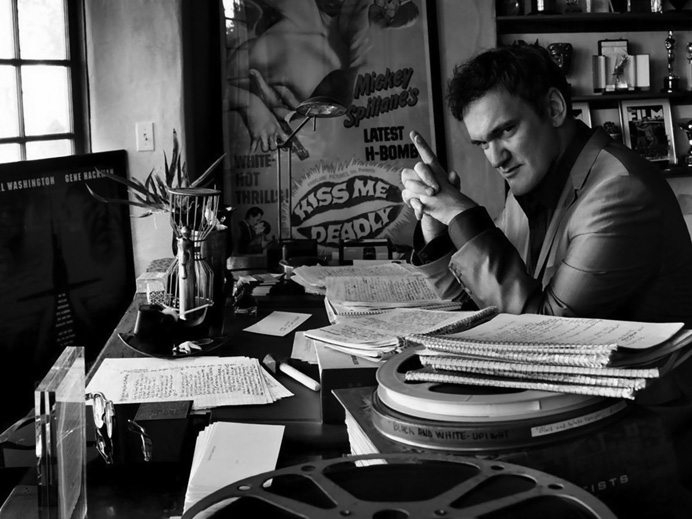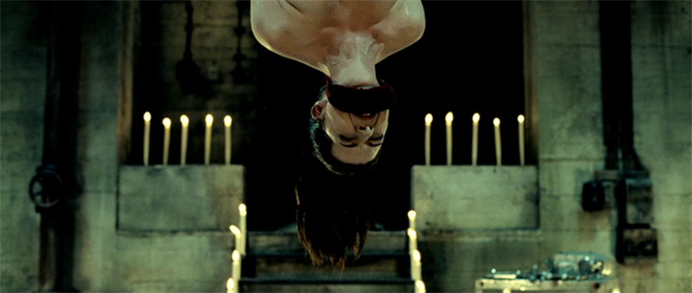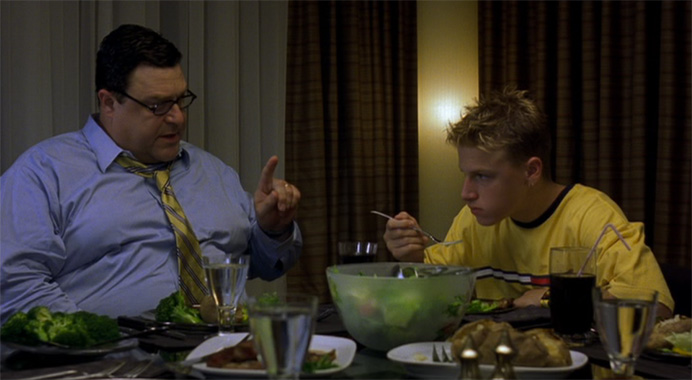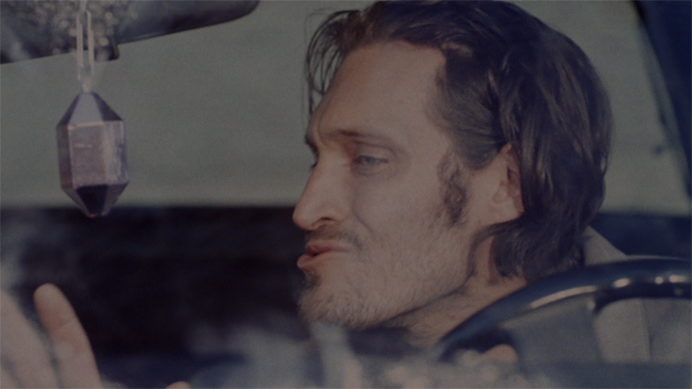 Quentin Tarantino, director of some actually good ‘cool’ movies. This is a companion piece to my 10 Awful Movies People Think Are Cool list. Read that one first. Or read this one first. It doesn’t really matter.
Quentin Tarantino, director of some actually good ‘cool’ movies. This is a companion piece to my 10 Awful Movies People Think Are Cool list. Read that one first. Or read this one first. It doesn’t really matter.
 10. Hostel: Part II | Dir. Eli Roth
10. Hostel: Part II | Dir. Eli Roth
I don’t like Hostel. It takes too long to get to the good stuff. And while we’re waiting, we have to listen to these annoying frat boys talk to each other. Hostel: Part II is the exact same movie but with hot girls, a more exotic location, a more precise and biting premise, a better ending, and a let’s-get started-right-away approach to the action. I like to think of Hostel as a practice movie, the ‘rough draft’ for Hostel: Part II, which is way more refined and tonally much more interesting. Plus, you get to see the girl from Welcome to the Dollhouse naked! But, to be serious, some of the imagery is so haunting that I don’t even like thinking about it. And rather than showing us said haunting imagery with inept, overdone, artificially intense handheld shots, Roth’s camera is static and objective. A door opens and we linger on a man tearing off a piece of a restrained, awake man’s leg as his victim screams in pain. Only movies can produce those kinds of images. Fucking nuts.

9. Storytelling | Dir. Todd Solondz
It’s interesting to me how Todd Solondz gets away with his blatant shock cinema approach. I think it’s because his style is so grounded and his tone is so inviting. His almost sitcom-esque scores brings delight to the reprehensible. Storytelling, or at least a section of it, is basically an indictment of my favorite movie of all time, American Movie. I don’t begrudge it for that, and in fact, I could be wrong, although it certainly reads that way and I’d love to know more. Either way, the shock moments (”fuck me, nigger” et al.) are effective, and also honest, and what we’re left with is a very fun, intelligent movie. This is shock cinema I can get behind.
 8. Goodfellas | Dir. Martin Scorsese
8. Goodfellas | Dir. Martin Scorsese
All of Scorsese’s movies are ‘cool’, even the awful ones like New York, New York or the ones nobody has seen like Kundun. His unabashed love for all things cinematic, and his kinetic, visceral attack on the viewer is cool under any title. Goodfellas is the coolest of his movies. Probably because it’s the best. And definitely not because it’s about the mafia. The mafia isn’t cool. Think of the biggest losers in your high school, the bullies that thought they were cool because they wore gold chains and were wannabe tough. Those guys weren’t cool. Goodfellas is cool because at the end of the movie, the main character gets out of his chair and starts talking at the camera. Because a slow motion shot pushes in on De Niro with Sunshine of Your Love in the background. Because of the violence and the red, the dialogue and the drugs. It’s cool from every possible angle, and Marty wouldn’t have it any other way.
 7. Scarface | Dir. Brian De Palma
7. Scarface | Dir. Brian De Palma
Apart from number one, this is the only other movie here that is famous solely for being cool. Despite that, it’s a good movie, albeit long as fuck. It’s probably longer than it needs to be, but let’s pretend the length is thematic, you know, because of excess or something. Scarface is like inverted Goodfellas, and while Goodfellas is a better movie, Scarface out cools it just a tad. It’s the flashy colors and beach babes that do it. For me, the cool factor of Scarface can defined by one shot. In its most horrific scene, Tony is about to have his arms cut off with a chainsaw. Where is his friend who’s supposed to be helping? He’s off flirting! A lesser filmmaker would simply cut to the friend. Not De Palma. De Palma wants you to feel the time, to be on the edge of your seat, to be nervous as fuck. So instead of just cutting to the friend, he uses a brilliantly slow and majestic crane shot to go all the way from the upstairs window down to the car across the street. It’s a shot like this that proves somebody’s filmmaking IQ. It’s a shot like this that proves a director wants the audience to feel something authentic, rather than merely impress them with flashy style. Shots like that are fucking cool. 
6. Buffalo ’66 | Dir. Vincent Gallo
Vincent Gallo is a fucking maniac. And with Buffalo ‘66, he certainly did a good job of recreating what it’s probably like to hang out with him for a day. And what he really did was make one of the most fun, crazy, hilarious ‘art films’ of all time. Buffalo ‘66 reeks of an indie stench that would make a lesser film unbearably pretentious. Gallo shot on 35mm color reversal stock so that he could achieve the gritty, washed out, 70‘s look he wanted. The film stock is long out of print and so unpredictable and difficult to process that the movie almost could’ve not existed at all. Using it was a total dice roll. It doesn’t get any more pretentious than that. Gallo is an obnoxious guy, but therein lies his genius. His unabashed and unapologetic desire to be stylistic, matched with his propensity to say hilarious things, like ‘I drive luxury cars, my cars shift themselves’, is where Buffalo ‘66 finds it’s heart. Underneath all the craziness, it’s actually a very human and emotional story about relationships and falling in love. But what makes it so cool is Gallo’s way of forcing you, and Christina Ricci, to follow him through his world of nonsense.

5. American History X | Dir. Tony Kaye
Here’s a movie everyone talked about when I was in middle school, nd why not? It’s got ‘badass’ violence and racism coming out of its ears. There’s something about American History X that just feels right though. Maybe it’s the wide lenses that really put you in Edward Furlong’s room. Maybe it’s the casting. Everyone from Ethan Suplee to Elliott Gould to Fairuza Balk are wonderful. And maybe it’s just the way the style tempers the melodrama. It enhances the reality instead of making it an after school special. Apparently, Tony Kaye wanted to take an Alan Smithee credit for some reason. Strange.
 4. The Matrix | Dirs. Lana & Andy Wachowski
4. The Matrix | Dirs. Lana & Andy Wachowski
I’m glad even Quentin Tarantino agrees that to talk about The Matrix, you have to ignore its sequels. The Matrix took everybody by surprise. All of sudden there was this movie with Keanu Reeves that had this whole new idea about living in virtual reality. It was all very edgy and topical as the internet was on the cusp of becoming the most normal thing ever and Y2K was steadily approaching. The ultimate achievement of The Matrix is that it is aware of itself just enough to get away with all the stylistic cyberpunk junk. Without the little nods to the camera (for instance, when Neo says “I know Kung-Fu”) the movie might not be cool at all.

3. Paradise Lost: The Child Murders at Robin Hood Hills and Paradise Lost 2: Revelations | Dirs. Joe Berlinger & Bruce Sinofsky
It’s very hard for me to discuss these films in a few short paragraphs. They are the best movies ever made, and being the best movies ever made, they demand more respect. What I will say is this—the end credits sequence of Paradise Lost 2 is the coolest sequence in movie history. The way the sound bites are punctuated by The Call of Ktulu by Metallica is bar none the coolest thing ever edited and printed to film. There is a third installment that is equally as good and completes the trilogy. The three combined are perhaps the highest achievement in cinematic history, not only for their artistic craftsmanship but also their real world effect—which only a small handful of movies ever made can lay claim to. However, since this is a list about being cool, I left off the third one since it is much more clinical by design. Which, it should be. But basically makes it less ‘cool’. If you haven’t seen these go watch them immediately.

2. First Blood | Dir. Ted Kotcheff I avoided First Blood for a very long time. Everybody knows what Rambo is, and you definitely don’t have to see any Rambo movies to know. When I say Rambo you think a jungle, machine guns, a flame thrower, and refugees in need of rescuing. Since all that shit is boring, I assumed First Blood was too. Finally, one day, I popped it in on a lark—one of the best decisions of my life. It started and I was on-board early on. All the while I kept thinking ‘when is it going to turn boring and cheesy?’. I figured at any point the governor was going to call and say ‘get me Rambo!’ and he’d be whisked away to some jungle to save a baby. It never happened. Instead, the action escalated, and what unraveled was a very dark, interesting action drama with intense but low-key violence and a very human conflict. First Blood is an intelligent character piece about prejudice and misunderstanding. The sequels that follow are exactly what you think of when you hear Rambo—they suck. Except for the 2008 one, that one wasn’t bad. Way better than those god awful Expendables movies.
 1. Pulp Fiction (1994) | Dir. Quentin Tarantino
1. Pulp Fiction (1994) | Dir. Quentin Tarantino
Pulp Fiction is the coolest movie ever made. In fact, it is the only movie in history that is good by virtue of being cool. Similar to Reservoir Dogs, Pulp Fiction is about nothing. While there are no character arcs in Dogs, Pulp Fiction has one very shallow one revolving around Jules quitting the biz. However, his arc is so underdone and unimportant to anything else that’s going on that you ultimately forget it’s even happening and don’t really care about it when it does. The movie itself is just a series of extended vignettes that sometimes intersect and are told out of order for literally no reason. If you think I’m picking on it or being reductive, just think about it for a second—I know you’ve seen the movie dozens of times, we all have. It opens with a long winded conversation about TV pilots and cheeseburgers. Two guys get killed and then there’s a gold watch and a boxer, a guy named Zed with a gimp, and some other stuff. Plus, the movie is two and a half hours long! When I say ‘for a reason’ I’m talking about how when you watch a normal movie like Groundhog Day and someone asks you why the day keeps repeating, the obvious answer is, so the main character learns his life lesson. The only thing like that in Pulp Fiction is that guy missing Vince and Jules with his ‘hand cannon’. It’s so minuscule it barely matters. If you can’t come up with a quick, simple answer to why a movie is doing a thing, the movie is probably awful. Pulp Fiction is the exception to the rule. But like I said, it’s good because it’s cool. Everything that happens is cool, from the soundtrack to the way it’s shot to the meticulously detailed dialogue. It’s the first time that an indie personality met the mainstream in such a powerful way that it changed the entire culture. Pulp Fiction isn’t just cool, it informed cool. And again, like most things, the devil is in the details. Minutia is the architect of cool. Before Pulp Fiction, Misirlou was a relatively obscure surf rock song by Dick Dale and the Deltones, a group only liked by forty year olds who wear Hawiian shirts, smoke pot, and really care about Les Paul. Pulp Fiction made the song a cultural phenomenon but not just because it’s in the movie. It’s all about the way it’s presented. Tarantino’s biggest strength is using long winded, wordy dialogue to build tension. The best examples of this are found in Inglourious Basterds—its opening scene is one of the best in movie history. The wordiness makes the dialogue feel more authentic, but it also gives time for percolation, which is a key proponent in building tension. The longer it takes to get from point A to point B the more we sweat. And the more the dialogue carries us along that path, the more tension we feel because dialogue sits on top and masks whats underneath. Honey Bunny and Pumpkin seem to talk forever, but the longer they talk the closer they get to deciding to rob the diner they’re in. Their decision to do it caps the scene, which is then punctuated by a freeze frame and the music cue—Misirlou. It’s the freeze frame that does it. Freezing to get you into Misirlou is perhaps the most influential decision in movie history and it solidified the movie’s coolness into eternity. Every kid that saw that freeze frame instantly wanted to be a filmmaker themselves. Whatever followed for the next two and half hours is academic. He had us at hello.